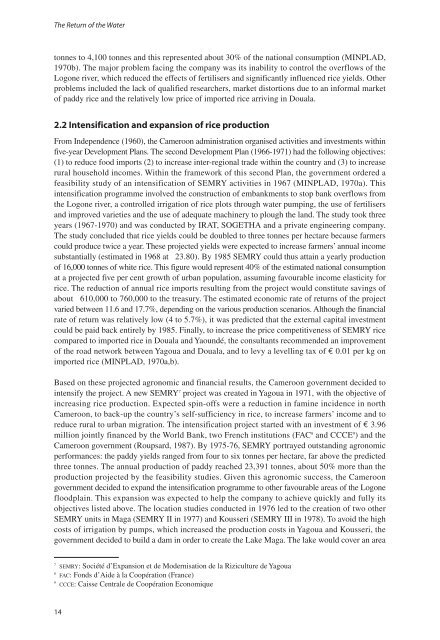The return of the water - IUCN
The return of the water - IUCN
The return of the water - IUCN
You also want an ePaper? Increase the reach of your titles
YUMPU automatically turns print PDFs into web optimized ePapers that Google loves.
<strong>The</strong> Return <strong>of</strong> <strong>the</strong> Water<br />
tonnes to 4,100 tonnes and this represented about 30% <strong>of</strong> <strong>the</strong> national consumption (MINPLAD,<br />
1970b). <strong>The</strong> major problem facing <strong>the</strong> company was its inability to control <strong>the</strong> overflows <strong>of</strong> <strong>the</strong><br />
Logone river, which reduced <strong>the</strong> effects <strong>of</strong> fertilisers and significantly influenced rice yields. O<strong>the</strong>r<br />
problems included <strong>the</strong> lack <strong>of</strong> qualified researchers, market distortions due to an informal market<br />
<strong>of</strong> paddy rice and <strong>the</strong> relatively low price <strong>of</strong> imported rice arriving in Douala.<br />
2.2 Intensification and expansion <strong>of</strong> rice production<br />
From Independence (1960), <strong>the</strong> Cameroon administration organised activities and investments within<br />
five-year Development Plans. <strong>The</strong> second Development Plan (1966-1971) had <strong>the</strong> following objectives:<br />
(1) to reduce food imports (2) to increase inter-regional trade within <strong>the</strong> country and (3) to increase<br />
rural household incomes. Within <strong>the</strong> framework <strong>of</strong> this second Plan, <strong>the</strong> government ordered a<br />
feasibility study <strong>of</strong> an intensification <strong>of</strong> SEMRY activities in 1967 (MINPLAD, 1970a). This<br />
intensification programme involved <strong>the</strong> construction <strong>of</strong> embankments to stop bank overflows from<br />
<strong>the</strong> Logone river, a controlled irrigation <strong>of</strong> rice plots through <strong>water</strong> pumping, <strong>the</strong> use <strong>of</strong> fertilisers<br />
and improved varieties and <strong>the</strong> use <strong>of</strong> adequate machinery to plough <strong>the</strong> land. <strong>The</strong> study took three<br />
years (1967-1970) and was conducted by IRAT, SOGETHA and a private engineering company.<br />
<strong>The</strong> study concluded that rice yields could be doubled to three tonnes per hectare because farmers<br />
could produce twice a year. <strong>The</strong>se projected yields were expected to increase farmers’ annual income<br />
substantially (estimated in 1968 at 23.80). By 1985 SEMRY could thus attain a yearly production<br />
<strong>of</strong> 16,000 tonnes <strong>of</strong> white rice. This figure would represent 40% <strong>of</strong> <strong>the</strong> estimated national consumption<br />
at a projected five per cent growth <strong>of</strong> urban population, assuming favourable income elasticity for<br />
rice. <strong>The</strong> reduction <strong>of</strong> annual rice imports resulting from <strong>the</strong> project would constitute savings <strong>of</strong><br />
about 610,000 to 760,000 to <strong>the</strong> treasury. <strong>The</strong> estimated economic rate <strong>of</strong> <strong>return</strong>s <strong>of</strong> <strong>the</strong> project<br />
varied between 11.6 and 17.7%, depending on <strong>the</strong> various production scenarios. Although <strong>the</strong> financial<br />
rate <strong>of</strong> <strong>return</strong> was relatively low (4 to 5.7%), it was predicted that <strong>the</strong> external capital investment<br />
could be paid back entirely by 1985. Finally, to increase <strong>the</strong> price competitiveness <strong>of</strong> SEMRY rice<br />
compared to imported rice in Douala and Yaoundé, <strong>the</strong> consultants recommended an improvement<br />
<strong>of</strong> <strong>the</strong> road network between Yagoua and Douala, and to levy a levelling tax <strong>of</strong> € 0.01 per kg on<br />
imported rice (MINPLAD, 1970a,b).<br />
Based on <strong>the</strong>se projected agronomic and financial results, <strong>the</strong> Cameroon government decided to<br />
intensify <strong>the</strong> project. A new SEMRY 7 project was created in Yagoua in 1971, with <strong>the</strong> objective <strong>of</strong><br />
increasing rice production. Expected spin-<strong>of</strong>fs were a reduction in famine incidence in north<br />
Cameroon, to back-up <strong>the</strong> country’s self-sufficiency in rice, to increase farmers’ income and to<br />
reduce rural to urban migration. <strong>The</strong> intensification project started with an investment <strong>of</strong> € 3.96<br />
million jointly financed by <strong>the</strong> World Bank, two French institutions (FAC 8 and CCCE 9 ) and <strong>the</strong><br />
Cameroon government (Roupsard, 1987). By 1975-76, SEMRY portrayed outstanding agronomic<br />
performances: <strong>the</strong> paddy yields ranged from four to six tonnes per hectare, far above <strong>the</strong> predicted<br />
three tonnes. <strong>The</strong> annual production <strong>of</strong> paddy reached 23,391 tonnes, about 50% more than <strong>the</strong><br />
production projected by <strong>the</strong> feasibility studies. Given this agronomic success, <strong>the</strong> Cameroon<br />
government decided to expand <strong>the</strong> intensification programme to o<strong>the</strong>r favourable areas <strong>of</strong> <strong>the</strong> Logone<br />
floodplain. This expansion was expected to help <strong>the</strong> company to achieve quickly and fully its<br />
objectives listed above. <strong>The</strong> location studies conducted in 1976 led to <strong>the</strong> creation <strong>of</strong> two o<strong>the</strong>r<br />
SEMRY units in Maga (SEMRY II in 1977) and Kousseri (SEMRY III in 1978). To avoid <strong>the</strong> high<br />
costs <strong>of</strong> irrigation by pumps, which increased <strong>the</strong> production costs in Yagoua and Kousseri, <strong>the</strong><br />
government decided to build a dam in order to create <strong>the</strong> Lake Maga. <strong>The</strong> lake would cover an area<br />
7 SEMRY: Société d’Expansion et de Modernisation de la Riziculture de Yagoua<br />
8 FAC:Fonds d’Aide à la Coopération (France)<br />
9 CCCE: Caisse Centrale de Coopération Economique<br />
14












